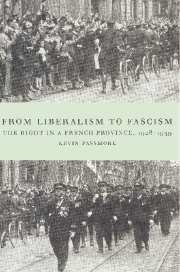Book contents
- Frontmatter
- Contents
- List of illustrations
- Preface
- List of abbreviations
- 1 Introduction
- 2 From France to the Rhône
- 3 Urban society in the Rhône
- 4 Rural society in the Rhône
- 5 The crisis of the right I: 1928–1932
- 6 The impact of the economic crisis
- 7 The crisis of the right II: 1932–June 1936
- 8 The Croix de Feu
- 9 The right and the Popular Front
- 10 Conclusion
- Appendix 1 Equations for multiple regressions
- Appendix 2 The conservative deputies of the Rhône, 1928–1940
- Select bibliography
- Index
9 - The right and the Popular Front
Published online by Cambridge University Press: 23 December 2009
- Frontmatter
- Contents
- List of illustrations
- Preface
- List of abbreviations
- 1 Introduction
- 2 From France to the Rhône
- 3 Urban society in the Rhône
- 4 Rural society in the Rhône
- 5 The crisis of the right I: 1928–1932
- 6 The impact of the economic crisis
- 7 The crisis of the right II: 1932–June 1936
- 8 The Croix de Feu
- 9 The right and the Popular Front
- 10 Conclusion
- Appendix 1 Equations for multiple regressions
- Appendix 2 The conservative deputies of the Rhône, 1928–1940
- Select bibliography
- Index
Summary
The general election of 26 April and 2 May 1936 produced an overall majority for the Popular Front of 378 seats. The discipline of the left benefited above all the PCF, which increased its seats from eleven to seventy-two, while the SFIO moved from 131 to 147 seats and therefore became the strongest party in the coalition. The main losers were the Radicals, who fell from 157 to 106 seats. The right gained only 220 seats. Political polarisation was reflected in an increase in the numbers of Fédération républicaine deputies and a decline of the centre-right. In the Rhône the election campaign had been characterised by unprecedented faction fighting on the right, exacerbated by the efforts of business organisations, veterans and the Croix de Feu amongst others to arbitrate in the ‘national interest’. This did not prevent the right from increasing its share of the registered electorate from 22% to 26%, and its deputies from three to five. Sallés and Peissel easily retained their seats. At Tarare Bonnevay obtained an absolute majority on the first round. Elmigar and Burgeot won the Croix-Rousse and Brotteaux respectively from the Radicals. Apart from the abnormal result of 1919, this was the best conservative result in the Rhône since 1871.
But the relative success of the right was a consequence of political polarisation. Even Bonnevay had lost 40% of his 1932 supporters to the nationalist Perret and had won only because the Radicals had not stood against him. The centre ground melted away as the Radical vote fell from 28% in 1932 to 16%, with the loss of five out of eight seats.
- Type
- Chapter
- Information
- From Liberalism to FascismThe Right in a French Province, 1928–1939, pp. 246 - 297Publisher: Cambridge University PressPrint publication year: 1997



